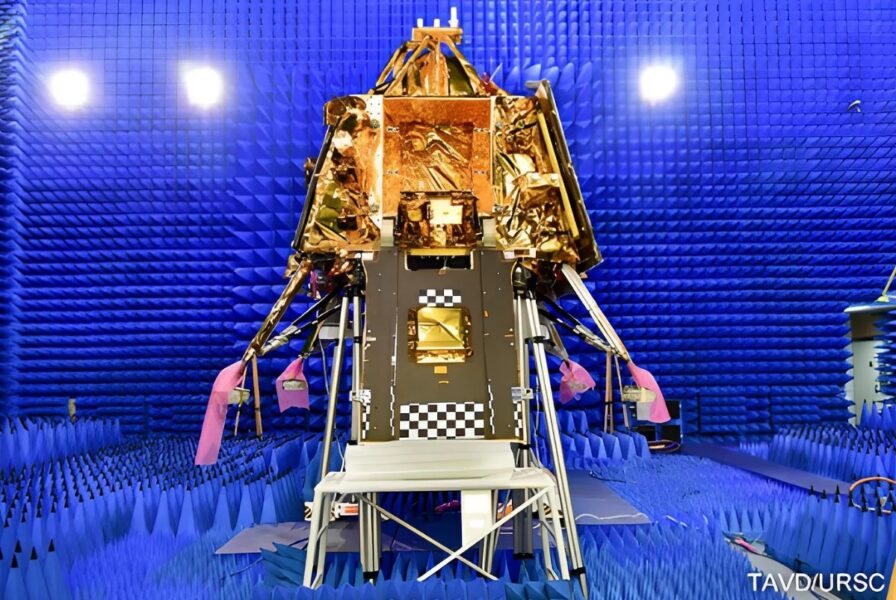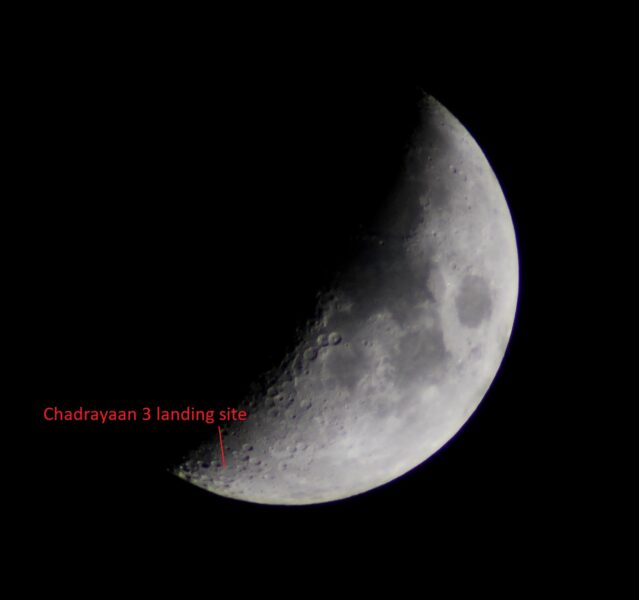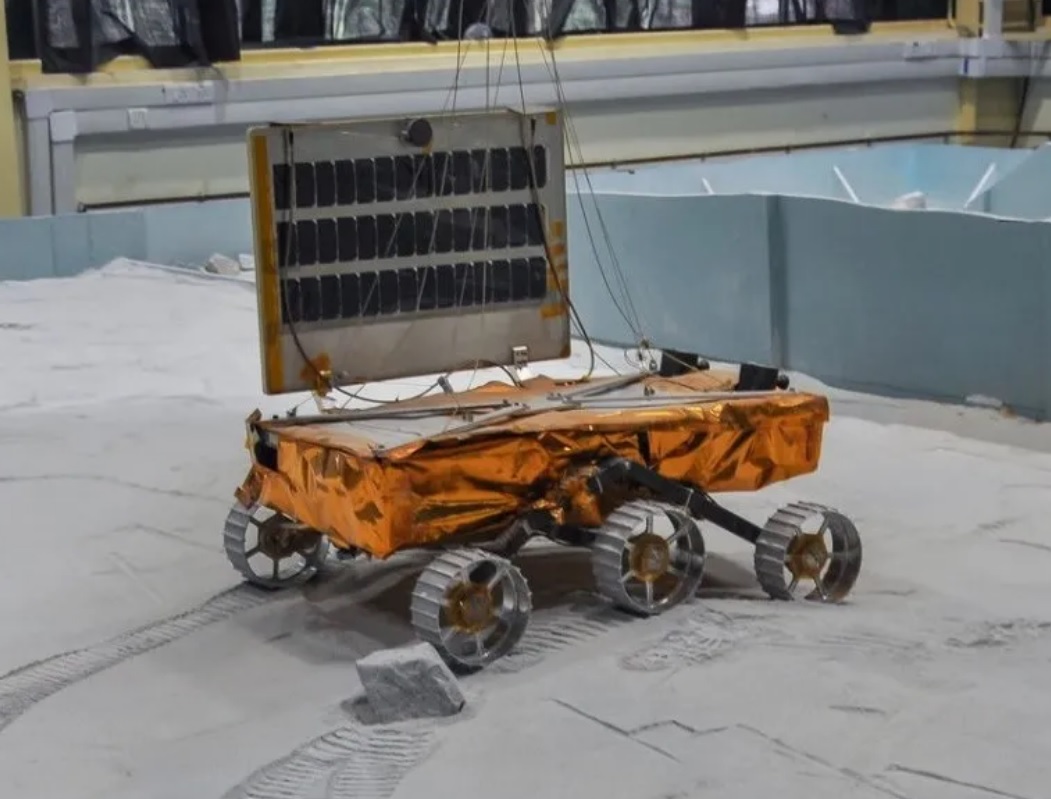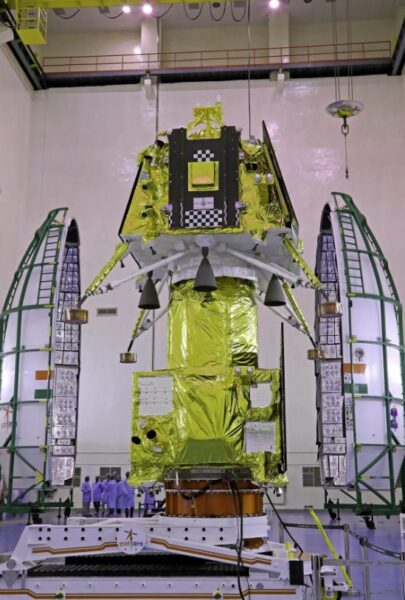India is headed back to the Moon with its ambitious new Chandrayaan 3 mission.
Updates:
(August 5, 2023): India's latest space mission, Chandrayaan 3, has entered lunar orbit. Read more about the orbit insertion from the Indian Space Research Organization. The Chandrayaan 3 mission has since posted a video of its latest maneuver:
The Moon, as viewed by #Chandrayaan3 spacecraft during Lunar Orbit Insertion (LOI) on August 5, 2023.#ISRO pic.twitter.com/xQtVyLTu0c
— LVM3-M4/CHANDRAYAAN-3 MISSION (@chandrayaan_3) August 6, 2023
An Indian Space Research Organization (ISRO) GSLV Mark 3 rocket leaped from the launch pad over Satish Dhawan Space Center today, July 14th, with India’s latest bid to land on the Moon: the Chandrayaan 3 mission. The launch was nominal and occurred at 5:05 a.m. EDT / 9:05 UT. Mission control reports that the spacecraft is in good health post launch.
The mission follows Chandrayaan 2, which launched in 2019 and successfully placed an orbiter around the Moon. Unfortunately, the lander of that mission crashed on the lunar surface. The lander of Chandrayaan 3 includes software and hardware changes to improve the chance of success.
The Chandrayaan 3 spacecraft will be placed in an elliptical parking orbit that measures 170 by 36,500 kilometers (150 by 22,680 miles). A series of engine burns will then boost it toward eventual lunar capture in early August.
"Congratulations to the team at ISRO for the historic launch of Chandrayaan 3," wrote India's Vice President Shri Jagdeep Dhankhar on Twitter. "The extraordinary feat highlights the advancement the country has made in space and science research. This milestone in India's stellar space journey makes every Indian proud!"
The mission outline for Chandrayaan 3 is very similar to Chandrayaan 2, and consists of an orbiter, the Vikram lander (named after Indian space pioneer Vikram Sarabhai), and the small 26-kilogram (57-pound) Pragyan rover.

ISRO
The mission is targeting a landing ellipse that measures 4 by 2.4 km, with landing set for August 23rd or 24th. The landing site is on the lunar nearside, near Mutus Crater in the lunar south polar region. This site should avoid any debris from the Chandrayaan 2 crash, which happened 100 km away, in between the Manzinus C and Simpelius N craters.

David Dickinson
Like the previous site, the new site is expected to contain ancient lunar crust and ejecta from the period of heavy bombardment during the early history of the solar system, 3.8 to 4.1 billion years ago. The timing for the landing attempt coincides with local lunar sunrise to give spacecraft imagers maximum terrain contrast and maximum survival time for the solar-powered lander and rover to explore their surroundings.
The Science Goals for Chandrayaan 3
The main objective of the Chandrayaan 3 mission follows that of the previous mission, to demonstrate landing and operational capability on the Moon. The lander and rover also carry a variety of science instruments, including a Langmuir probe to measure plasma density changes near the surface of the Moon, a seismometer, and a laser retro-reflector array provided by NASA. The rover also carries an independent Alpha Particle X-ray spectrometer and Laser Induced Breakdown Spectroscope (LIBS).
The Chandrayaan 3 rover could also find ground-truth evidence for the presence of water ice near the lunar poles, which Chandrayaan 1 first saw from orbit in 2009.

Chandrayaan 2 vs. Chandrayaan 3
Although the orbiter-lander stack looks similar, the Chandrayaan 3 orbiter is much simpler than the Chandrayaan 2 spacecraft: It’s a simple propulsion and relay unit meant to support the lander and rover.
The Spectro-polarimetry of Habitable Planet Earth (SHAPE) is the only science experiment aboard the orbiter, and it will separate after the deployment of the rover and lander is complete. SHAPE will study the full-disk spectrum of Earth from the perspective of lunar orbit with the idea of seeing our home as an exoplanet. The mission's science goal is to to characterize methods to analyze and detect potentially habitable distant worlds. Both SHAPE and the orbiter unit will remain in a 100-km orbit around the Moon.
The Chandrayaan 3 lander, however, features several improvements over the one that crash-landed on the Moon in 2019. Those include new and upgraded tracking antennas, redundant navigation systems, new hazard avoidance cameras, and most importantly software upgrades.
The new lander only has four engines, as opposed to five on the previous lander. It also includes a new Laser Doppler Velocimeter, which will assist in landing, as well as reinforced landing struts. Another advantage for Chandrayaan 3 is the availability of high-resolution images of the landing site, courtesy of previous Chandrayaan missions.

ISRO
"The current global consensus is that the next steps in addressing major lunar science objectives will be robotic exploration and return of samples from the surface of the Moon, with a particular emphasis on regions not previously visited," says Sriram Bhiravarasu (Lunar and Planetary Institute) in a recent Planetary Report article. "Knowing that there is increased international interest in a human presence on the Moon, the timing . . . couldn't be more perfect!"
The $90 million mission demonstrates ISRO’s ability to do more with less. Compare this cost with the $250 million price tag for NASA’s upcoming VIPER lunar rover, expected to launch in November 2024. Chandrayaan 3 follows the lunar and planetary exploration agenda for Indian space program, which has also included Chandrayaan 1 and 2 and the Mars Orbiter Mission. Future plans include a possible partnership with Japan’s space agency to explore the lunar poles in 2025.
Chandrayaan 3 is part of a series of new missions heading moonward in 2023. If successful, India could become the fourth nation behind the U.S., the Soviet Union, and China to successfully land on the Moon.
Astronomer Gianluca Masi will feature a live feed tonight, tracking Chandrayaan 3 in orbit starting at 8 p.m. EDT / midnight UT.
 3
3
Comments
donbrabston
July 15, 2023 at 1:47 pm
I presume the article meant to say that "The $90 million mission ... do more with less" rather than "less with more". The latter would be fairly easy, I assume.
You must be logged in to post a comment.
Monica Young
July 17, 2023 at 10:21 am
Thanks for catching this, Don, we've edited the text accordingly.
You must be logged in to post a comment.
Aniruddha
July 16, 2023 at 12:36 pm
With Chandrayaan 2 in 2019, I recall how I was simultaneously watching three news channels on my phone, tv, and computer, holding my breath for a few seconds before celebrating ISRO's momentous achievement of a soft landing. Unfortunately, Vikram crash landed. The rest of the mission was perfect though. I hope everything goes as planned this time. Godspeed Chandrayaan 3.
You must be logged in to post a comment.
You must be logged in to post a comment.